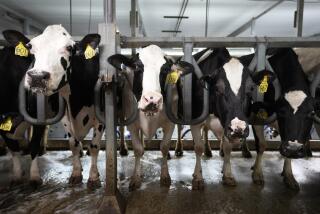FDA Moves to Prevent ‘Mad Cow Disease’ Transmission
- Share via
WASHINGTON — The Food and Drug Administration took steps Thursday to ban the use of cow, sheep and goat tissue in most animal feeds to ensure against the transmission of “mad cow disease,” which has been linked to at least 10 cases of a fatal human neurological disorder in Britain.
Health and Human Services Secretary Donna Shalala called the U.S. action “precautionary,” because there have been no cases of the disease reported in the United States. Last year, the U.S. livestock industry said it would voluntarily eliminate such tissue from cattle feed sold to American farmers.
Animals contract the infection by eating feed that has been supplemented by the tissues of infected animals. Humans are believed to acquire the disease by eating infected beef. It results in the formation of sponge-like holes in the brain and there is no known treatment or cure.
The proposed regulation, which is subject to a 45-day public comment period, is the latest in a series of measures taken by the FDA, other federal agencies and the industry to prevent animals from becoming infected, and to minimize the chances of their transmitting such diseases to humans. The rule will likely become effective later this year.
The disease, known as bovine spongiform encephalopathy (BSE), is one of the more commonly known of a group of animal diseases called transmissible spongiform encephalopathies (TSEs). In animals and humans, TSEs are characterized by a long incubation period, a relatively short course of neurological symptoms and a death rate of 100%.
The National Cattlemen’s Beef Assn. called the FDA action “an appropriate next step to prevent [BSE] from ever occurring in the U.S.,” and predicted it would have “little effect” on the cost of producing beef and milk. Before the industry voluntarily removed the products, producers used only about 15% of available animal tissue by-products in their feed, the trade group said.
Tissues from “ruminant,” or cud-chewing, animals--such as sheep, goats, cattle, elk and deer--are often used to supplement the diets of the same kinds of animals. Under the new regulation, the tissue from ruminant animals could not be used in the feed of ruminant animals.
Mink tissue would also be prohibited from feed, because minks also can become infected.
The rule does not apply to poultry feed, however, because there is no evidence that poultry can become infected with or transmit TSEs.
“If, for some reason, a case of BSE were to occur in the U.S.--and it is important to emphasize that not even one case of BSE has ever been found here--the steps we are taking today would confine it to the individual animal, and greatly decrease the potential risk to humans,” said FDA Commissioner David A. Kessler.
The first case of BSE was reported in 1986 in Britain, and an investigation has suggested an association between the disease and the feeding to cattle of protein derived from sheep infected with scrapie, another TSE.
Recently, British authorities have linked BSE to a variant of Creutzfeldt-Jakob disease, which caused 10 deaths in Britain.
In addition, the proposal calls for certain process and control systems to ensure that ruminant feeds do not contain the prohibited tissue.
Since 1989, no cattle have been imported from countries with confirmed cases of naturally occurring BSE. Further, no beef has been imported from foreign countries with cases of BSE in cattle since 1985.
Through Nov. 15, about 165,000 head of cattle in more than 33,000 herds were diagnosed with BSE in Britain.
The disease also has been found in domestic cattle in Ireland, France, Portugal, Oman and Switzerland. The epidemic peaked in January 1993, at nearly 1,000 new animal cases every week; currently, fewer than 200 suspected cases are diagnosed weekly.
More to Read
Sign up for Essential California
The most important California stories and recommendations in your inbox every morning.
You may occasionally receive promotional content from the Los Angeles Times.










